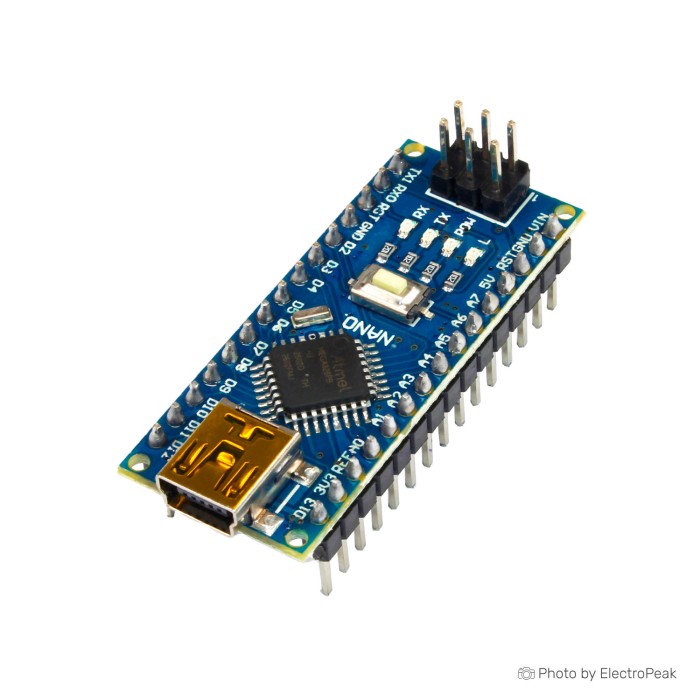Just like the original Arduino Nano boards, you can power this board with an external power supply of up to 12v (like adapters, or batteries).
Arduino Nano (Clone)
Volume discounts:
- +25 4 % $2.6300
- +100 7 % $2.5700
- +300 9 % $2.5100
- +500 11 % $2.4500
- +1000 13 % $2.4000
 Nano CH340G Development Board (Clone to Arduino Nano 3.0)
Previous
Nano CH340G Development Board (Clone to Arduino Nano 3.0)
Previous

An Arduino Nano Clone is a replica or imitation of the original Arduino Nano, which is an official Arduino board. Clones are typically produced by third-party manufacturers and are designed to be functionally equivalent to the official boards. These clones are often more affordable than official Arduino products, making them popular among hobbyists and makers on a budget. While the components and layout may vary slightly from the original, the Nano clone is compatible with the Arduino software and can be programmed using the same IDE, making it a practical choice for those seeking a budget-friendly option for their projects.
Arduino Nano is a microcontroller board based on the ATmega328P, the same chip used in the popular Arduino Nano board. It has 22 digital input/output pins (14 of which can be used as PWM outputs), 8 analog inputs, a 16 MHz ceramic resonator (CSTCE16M0V53-R0), a USB connection, a power jack, an ICSP header and a reset button. It contains everything needed to support the microcontroller; simply connect it to a computer with a USB cable or power it with an AC-to-DC adapter or battery to get started. You can tinker with your Nano without worrying too much about doing something wrong, worst case scenario you can replace the chip for a few dollars and start over again.
Specifications of Arduino Nano Clone:
The Arduino Nano Clone has the same specification of Arduino Nano:
- Microcontroller: ATMega328P
- Architecture: AVR
- Operating Voltage: 5 V
- DC Current per I/O Pins: 40 mA (I/O Pins)
- Power Consumption: 19 mA
- USB-to-Serial Converter: FT232RL chip.
- Input Voltage: Accepts a voltage range of 7-12V when powered via the VIN pin or 5V when powered via the USB port.
- Digital Pins: Offers 14 digital input/output pins, each of which can be used for digital input or output and supports PWM (Pulse Width Modulation).
- PWM Output: 6
- Analog Pins: Provides 8 analog input pins for reading analog sensor values.
- UART, I2C, and SPI: Includes UART (Serial), I2C, and SPI communication interfaces, expanding its connectivity options.
- Flash Memory: Features 32KB of flash memory, of which 2KB is used for the bootloader.
- SRAM: Contains 2KB of SRAM for variable storage during program execution.
- EEPROM: Includes 1KB of EEPROM for non-volatile data storage.
- Clock Speed: Operates at a clock speed of 16 MHz for rapid program execution.
- Dimensions: 18.5mm x 45mm.
- Integrated Components: Include built-in components such as LEDs, reset button, and voltage regulator for ease of use.
- Compatibility: Compatible with the Arduino IDE, allowing you to program it using Arduino sketches and libraries.
- Please note that the exact specifications may vary slightly between different clone manufacturers, so it's advisable to refer to the specific datasheet or product documentation provided by the manufacturer when working with a particular Arduino Nano clone.
Difference between Arduino Nano V3.0 original and its clone
Arduino Nano V3.0 boards can be found both in original versions produced by Arduino and in clones manufactured by various Chinese companies.
We will introduce you the differences that the original Arduino board and the copy may have.
It is necessary to point out that the version that is sold on our site is an exact clone of the original board and in terms of functionality and quality, they are not different from the original version.
Here are some general differences that are often observed between original Arduino Nano V3.0 boards and their Chinese clones:
- Build Quality: Original Arduino boards are typically manufactured to higher quality standards. The components used, soldering quality, and overall build may be superior to some Chinese clones.
- Component Quality: Original Arduino boards often use higher-quality components, which can contribute to better performance and durability. Chinese clones may use cheaper components to reduce costs.
- Pricing: Original Arduino boards are generally more expensive than Chinese copies. The lower cost of Chinese copies may make them attractive to budget-conscious users.
- Clones and Variations: Some Chinese clones are exact clones of the original Arduino Pro mini, while others may have slight variations in design or component placement.
- Manufacturing Origin: Original Arduino boards are manufactured in Italy or other authorized locations. Chinese clones, as the name suggests, are often manufactured in China.
It's important to note that not all Chinese copies are of poor quality, and some function perfectly well. However, users should be aware of potential differences in quality when choosing between an original Arduino Nano V3.0 and a Chinese clone.
Considering the price difference in most cases, buying a quality copy of Arduino is a more suitable option for most users.
Pinout of Arduino Nano Clone
The pinout of the clone version of Arduino Nano (clone) is quite much similar to its original version. You can see the pinout of Arduino Nano V3.0 in the following image:
How do I power the Arduino Nano Clone?
Can I program Arduino Nano Clone with Python?
Yes. But it’s better not to do this. If you are interested in Python programming, you can use Raspberry Pi pico or ESP32/ESP266 based development boards.
What programming language does Arduino Nano Clone use?
Arduino Nano (clone) is compatible with all of softwares/hardwares that used for genuine Arduino Nano. So, it can be programmed using Arduino IDE and Platform IO.
What is the maximum current I can draw from each pin on Arduino Nano Clone?
Each digital or analog pin on the Arduino Nano can source or sink a maximum current of 20 mA. The total current for all pins should not exceed 200 mA.
Can I use shields designed for other Arduino boards with Arduino Nano Clone?
In most cases, No. Arduino Nano is not compatible with most of the shields designed for other Arduino boards. However, most of them may be connected by pin arrangement. You can choose and buy the one you want from the variety of Arduino shields available on the site.
What can I do with Arduino Nano Clone?
All the things that you could do with the original Arduino Nano, you can do with this board. The possibilities with Arduino Nano are vast, and the open-source nature of the Arduino platform means there is a wealth of resources, tutorials, and community support available to help you with your projects. Whether you're a beginner or an experienced maker, Arduino Nano provides a great platform for learning and creating.






Please complete your information below to login.
Sign In
Create New Account